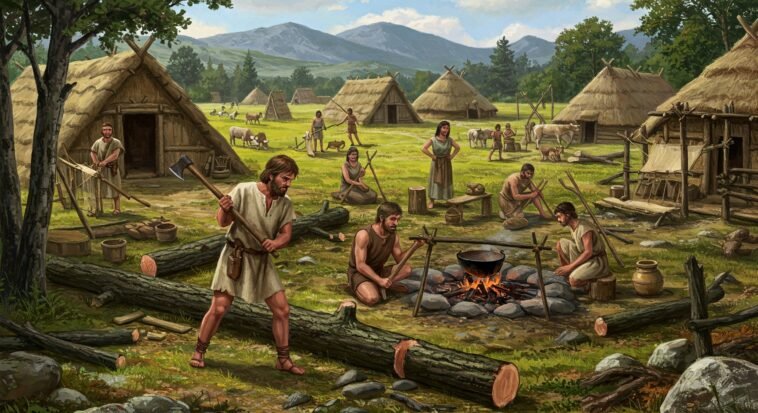
The Bronze Age (around 3300–1200 BCE) wasn’t just about shiny weapons and epic ruins—it was the era that kickstarted cities, trade routes, and even the first scribbles of written language.
But beyond the big history headlines, it’s the everyday stuff that really brings these ancient people to life.
Ever wondered what they actually ate 4,000 years ago? Or what their homes looked like—think less “castle” and more “ancient Airbnb”? And how did their communities even work?
This guide dives into the real deal: food on the table, the roof over their heads, and who called the shots.
Ready to peek into the daily grind of our Bronze Age ancestors? Let’s go!
Why the Bronze Age Still Matters
The Bronze Age isn’t just about old, dusty stuff in museums—it’s basically the OG blueprint for modern life.
Think of it as the ultimate “origin story” for a lot of what we do today.
From Mesopotamia to the Indus Valley, Minoan Crete to ancient China, these civilizations kicked off the basics: farming, trading, building epic structures, and running things like pros.
Without them, no cities, no internet memes, no streaming your favorite shows.
So yeah, the Bronze Age might be ancient history—but it’s the foundation under everything cool about our world now. Pretty wild, right?

Food in the Bronze Age: What Was on the Menu?
1. Farming and foraging—the everyday eats
Bronze Age folks were part-time farmers, part-time gatherers—kind of like ancient foodies before it was cool.
Thanks to science digging into old pots and stuff, we know their diets were mostly plants, but it changed depending on where they lived.
Their go-to staples?
- Barley and wheat: The original carbs powering bread, porridge, and even beer (yes, beer’s been around that long).
- Lentils, peas, and beans: Protein-packed and perfect for a plant-based flex.
- Flax: Not just for fancy scarves—used for oil and fiber.
And their veggie and fruit lineup included figs, onions, leeks, and turnips—basically Bronze Age superfoods.
2. Meat and dairy
Meat wasn’t an everyday thing for most people—think of it as the Bronze Age version of “treat yourself” days.
The wealthy or special occasions got the prime cuts.
Animals on the menu included:
- Domesticated: Sheep, goats, pigs, and cows.
- Wild game: Deer, boar, and birds if you lived near forests.
- Fish: The coastal and river folks got fresh catches regularly.
Dairy was a big deal, especially in Europe and the Near East.
Milk and cheese showed up in meals more than you’d think—recent research even found milk traces in ancient pots (yes, Bronze Age cheese was a thing!).
3. Cooking methods
No microwaves here—these ancient cooks used:
- Open fires and clay ovens for roasting and baking
- Pots for boiling stews
- Skewers for roasting meat over flames
For flavor? Herbs, salt, and a splash of honey for sweetness.
Imagine ancient Bronze Age baklava—but simpler.
So yeah, their food wasn’t just survival fuel—it was the start of cooking as an art form.
Pretty tasty for 4,000 years ago!
Bronze Age Homes: Structures and Settlements
1. Building Materials
What homes looked like depended on where people lived, but they got creative with what was around:
- Wattle and daub: Think of it as ancient IKEA furniture—wood strips woven together and covered with mud plaster.
- Sun-dried bricks: Popular in places like Mesopotamia and Egypt, basically the Bronze Age version of baking clay cookies.
- Stone foundations: Common in Europe and around the Mediterranean, because sturdiness was key.
Roofs? Mostly thatched or made from reeds and wood.
Most folks lived in one-room homes, but the richer crowd—looking at you, Minoan Crete—had multi-room houses with courtyards, storage pits, and even early indoor plumbing.
Yep, they were basically the VIPs of their time.
2. Village layouts
Communities varied but usually fell into a few categories:
- Agricultural villages: Self-sufficient setups with fields and animal pens, kind of like tiny farm towns.
- Fortified settlements: With stone walls, moats, or ramparts to keep the riffraff out. Imagine Game of Thrones, Bronze Age edition.
- Urban centers: Places like Mohenjo-Daro and Mycenae had roads, markets, and temples—basically the ancient version of your local downtown.
3. Furniture and interiors
Inside, people kept things practical but comfy:
- Benches and low stools made from clay, wood, or stone (no IKEA assembly required).
- Clay ovens for cooking and storage jars to keep food safe.
- Walls often had hangings made from linen or wool—early interior decorating vibes.
- For sleeping? Reed mats or wool blankets, sometimes on raised platforms, sometimes right on the floor. Not quite luxury hotels, but hey, it did the job.
So, Bronze Age homes might seem simple, but they had all the basics covered—and a few surprises that show they were smarter about living than you’d think.

Social Structure: Roles, Ranks, and Responsibilities
1. Hierarchical Society
Bronze Age societies ran on a strict hierarchy—think of it like the ultimate social ladder, but with fewer LinkedIn connections and more bronze weapons. Here’s the lineup:
| Rank | Description |
| Kings and rulers |
Controlled cities and trade routes
|
| Nobles and priests |
Landowners, religious leaders
|
| Craftspeople and merchants |
Skilled workers, traders
|
| Farmers and laborers |
Majority of the population
|
| Slaves or bonded laborers |
Lowest class, often war captives
|
This setup stayed solid thanks to land control, religious power, and mastery of metalworking—the Bronze Age equivalent of owning the hottest tech.
2. Gender roles
Most places had pretty clear roles:
- Men as warriors, landowners, and big decision-makers.
- Women running the household, raising kids, weaving, and cooking up the daily meals.
But here’s a plot twist: archaeology tells us it wasn’t always so clear-cut.
Take the “Lady of Vix” in France—buried with a chariot and weapons around 500 BCE—proof that some women had serious power, like Bronze Age Wonder Women.
3. Trade and economy
Trade wasn’t local—it was epic. Bronze Age societies swapped all kinds of goods:
- Tin and copper, the dynamic duo for making bronze.
- Textiles and pottery, because everyone needs a good outfit and some stylish storage.
- Grain and livestock, the staples that kept people fed.
- Luxury items like amber, ivory, and gold for those who liked to flaunt their wealth.
Trade routes connected hotspots like Mesopotamia, the Indus Valley, and the Mediterranean, creating one of the earliest versions of a global economy—basically the ancient world’s version of Amazon Prime, but slower.
Tools and Technologies That Shaped Daily Life
1. Bronze tools and weapons
Bronze—the OG high-tech upgrade—changed everything.
It’s basically copper and tin teaming up like the ultimate superhero duo. Here’s what it helped with:
- Farming gear: Sickles, ploughshares, and axes made planting and harvesting way smoother—goodbye, Stone Age struggle!
- Household essentials: Knives for chopping, cauldrons for cooking stews, and pins to keep those ancient outfits in place.
- Weapons: Spears, swords, and arrowheads to defend the homestead or impress at the Bronze Age Battle Royale.
Thanks to these tools, people farmed smarter, built better, and fought tougher.
2. Pottery and storage
Ceramics weren’t just artsy—they were lifesavers:
- Cooking pots that got meals on the table.
- Storage jars for grains and liquids—because nobody wanted spoiled food (or spilled wine).
- Transport vessels for trade goods—think of them as Bronze Age Amazon boxes, but way cooler.
And let’s not forget style points!
Mycenaean pots rocked spirals, while Indus Valley wares showed off animal carvings—early flexes of regional flair and social status.
3. Textile production
Clothes came from wool and flax, spun and dyed by hand.
Looms and spindles were household staples, turning raw fibers into wearable art.
- The richer you were, the brighter and fancier your threads—because in the Bronze Age, fashion was all about showing off your social rank.
So yeah, these tools and tech weren’t just practical—they helped shape everyday life and style way back when.
Bronze Age hustle, meet Bronze Age swag.
Religion and Ritual in Daily Life
Bronze Age folks lived with gods and goddesses on speed dial—nature, fertility, war, and afterlife deities all had starring roles in their daily lives.
Think of it like a whole divine Avengers team keeping an eye on things.
Their spiritual routines included:
- Sacrifices: Animals or food offerings to keep the gods happy—kind of like ancient “thank you” gifts.
- Seasonal festivals: Big communal parties marking the changing seasons and hoping for good luck (and maybe an excuse to eat, drink, and be merry).
- Burials with swag: People were buried with goods—tools, jewelry, sometimes even food—to make sure they were set for the afterlife.
Temples weren’t just spiritual hotspots; they doubled as political HQs.
Picture the ziggurats of Mesopotamia or the grand palaces of Minoan Crete as the ancient version of a city hall mixed with a church—and maybe a little bit of a celebrity hangout.
Religion was woven into everything, from daily chores to major life events, making the Bronze Age world as much about faith as it was about bronze.

Regional Variations in Bronze Age Life
Sure, the Bronze Age had some common threads—but each region added its own flavor to the mix:
1. Mesopotamia (Iraq/Iran)
Think of this as the birthplace of the urban hustle—irrigation systems keeping farms alive and cuneiform writing getting the message across.
Their ziggurat temples weren’t just for worship; they were power centers where city bosses called the shots.
2. Indus Valley (Pakistan/India)
These folks were city-planning pros.
Mohenjo-Daro’s grid layout was like the OG version of a modern city map.
They had fancy sanitation systems (way ahead of their time) and trade routes linking them to distant lands.
3. Minoan Civilization (Crete)
If you love palace drama and epic adventures, the Minoans were your crew—think sprawling palaces, seafaring trade, and the wild sport of bull-leaping.
Art and rituals were their jam, making life a bit more colorful and exciting.
4. Northern Europe
Smaller scale but still cool—cozy farming villages and hillforts dotted the landscape.
And their burial mounds? Think of Tollund Man, the perfectly preserved “ghost” from Denmark, as history’s own time capsule.
Each place had its own vibe, showing that the Bronze Age was as diverse as a Netflix binge list.
Conclusion: What the Bronze Age Teaches Us Today
The Bronze Age wasn’t just about shiny metal—it was the kickoff for cities, trade, and culture as we know it.
Looking at what people ate, where they lived, and how they organized themselves, we get more than history—we get real stories of people figuring life out, just like us.
Even after thousands of years, their struggles and wins still hit home.
They worked hard to build homes, grow food, and make sense of the world—kind of like us trying to adult every day.
Their early wins in farming, building, and leadership set the stage for everything that came after.
So, diving into their daily lives isn’t just nerdy archaeology—it’s like scrolling through the original human playlist, showing us how societies grow and evolve.



